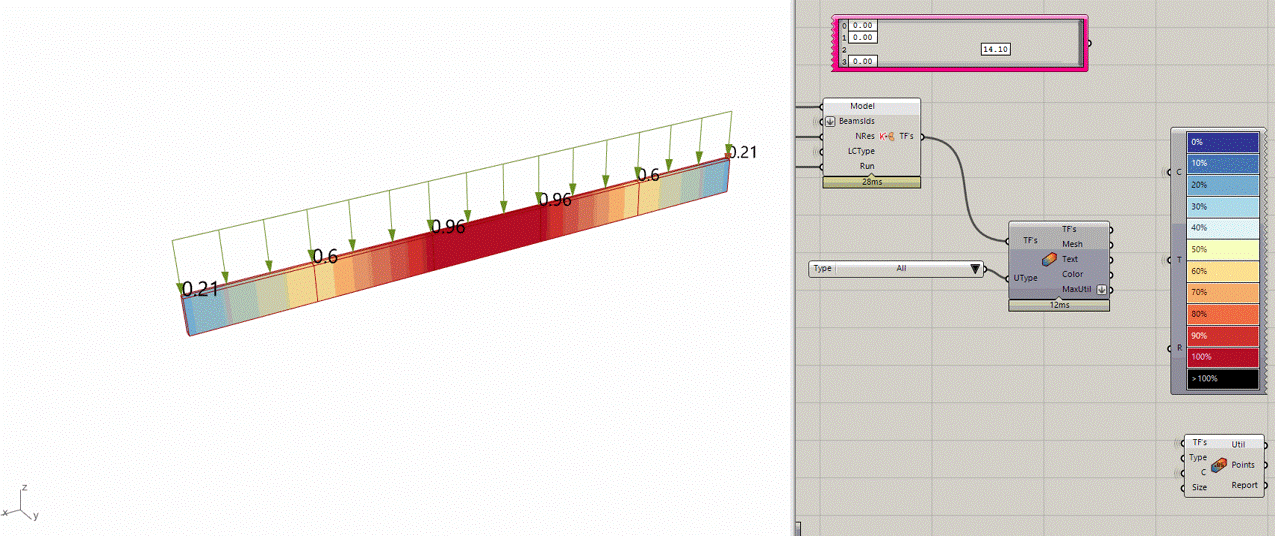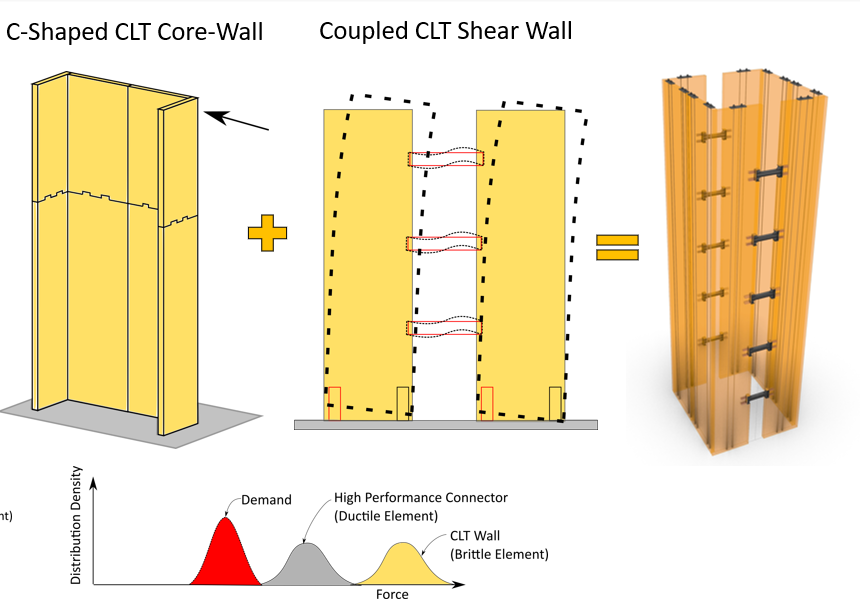CLT Shear Walls & Parametric Design: Research & Development
In the quickly evolving field of timber engineering and construction, staying at the forefront of research & development is crucial to efficient design. In this blog, we delve into three topics presented by our team members at two major international engineering conferences this past month.
Their groundbreaking work explores the realms of experimental testing of CLT shear walls and parametric design frameworks for timber engineering. Read more to discover how these studies are shaping the future of structural engineering.
Experimental Testing of High-Capacity Single and Coupled CLT Shear Walls
Ben Moerman, Minghao Li | University of Canterbury
2023 World Conference on Timber Engineering, Oslo
This paper presents an experimental study on three types of balloon-framed cross-laminated timber (CLT) shear wall configurations: (a) a single wall, (b) a coupled wall with a half-lap joint between wall piers, and (c) a coupled wall with steel link beams between wall piers. Three-storey, 2/3-scale CLT wall specimens were cyclically tested to failure at the University of Canterbury and the results are presented to compare the performance between wall types. All specimens used 5-ply, 205mm- thick CLT wall panels with the same base connections of mixed-angle screw hold-downs and notched shear keys.
The beam-coupled wall achieved a peak strength of 592kN and demonstrated the best seismic performance among the wall configurations with the highest strength, stiffness, energy dissipation, and least amount of degradation under repeated load cycles. All the wall specimens exhibited ductile failure modes and demonstrated their feasibility to be designed for lateral load resisting systems in buildings.
Beaver: A Parametric Design Framework for Timber Engineering

Marcio Sartorelli, Renan Prandini, Joao Tavares Pini
2023 World Conference on Timber Engineering, Oslo
Developments in digital modeling tools and the growing emphasis on low-carbon buildings have significantly increased the complexity of timber structural engineering. In this presentation, Marcio Sartorelli and colleagues from Beaver Structures introduce the ongoing advancements and applications of Beaver, an open-source plugin designed for the Rhino3D and Grasshopper environment. Beaver enables live-fed parametric analysis and design of timber structures, including elements and connections, in accordance with the "Eurocode 5 - Design of Timber Structures."
By leveraging Grasshopper and finite element analysis plugins like Karamba3D, structural data can be seamlessly integrated into Beaver, facilitating integrated timber ultimate limit state (ULS) and serviceability limit state (SLS) analysis. This integration allows for performance-based design (PBD), merging structural conception and timber structural engineering into a single decision-making step. The presentation showcases various case studies that demonstrate the potential benefits of using Beaver in timber engineering practice. These examples explore how the integration of computational engineering tools, such as form-finding, genetic algorithms, and spatially associative problems, not only unlocks a range of design possibilities but also ensures structural safety throughout the process.
A quote from ITA Timber Engineering's Head of Engineering, Joao Pini:
“ At ITA, we employ Beaver as a valuable tool for conceptual design, and it has demonstrated its effectiveness in our form-finding processes.
This recent project serves as a good example: Beaver was employed to find the optimal solution for a twenty-meter span fishbelly truss, designed for a boat hangar prototype in Brazil. What is interesting about this truss is that the desired curvature was achieved through the assembly process, which imposes a significant bending pre-stress that is crucial in the analysis.
It was a pleasure to connect and meet some members of StructureCraft's team in Oslo. I would be happy to assist anyone interested in using or contributing to this open-source project."
Learn more about ITA Timber Engineering and their amazing work with Beaver here: https://www.instagram.com/itaconstrutora/
Food4rhino: https://www.food4rhino.com/en/app/beaver
Graphics: João Pini, Head of Engineering at ITA Timber Engineering
Investigation of a Post-Tensioned CLT Core-Wall with Steel Link Beams for a Lateral Load Resisting System

Justin Brown, Ben Moerman, Lucas Epp, Steve Barg, Minghao Li, Francesco Sarti, Tobias Smith | University of Canterbury
2023 Canadian-Pacific Conference on Earthquake Engineering, Vancouver
Recently completed research by Justin Brown on C-shaped post-tensioned (PT) cross-laminated timber (CLT) core-walls, utilizing the Pres-Lam system, has highlighted their lateral load resisting capability and provided valuable data for numerical model calibration. In parallel, cyclic tests on coupled CLT shear walls with steel link beams exhibited a ductile failure mode, demonstrating desirable yielding of the link beams connecting adjacent CLT shear walls. This study, completed at the University of Canterbury, proposes the combination of these two high-capacity mass timber shear wall systems as a PT core-wall assembly to effectively resist earthquake loading around elevator shafts or stair cores. The system comprises two C-shaped core-walls coupled by a series of steel link beams along its height.
Using the National Building Code of Canada 2015 and assuming factors of Rd = 3.0 and Ro = 1.5, a 6-storey sample building was designed following the equivalent static force procedure. A nonlinear model was calibrated based on experimental results from C-shaped PT and beam-coupled walls. Nonlinear pushover analyses were conducted in each orthogonal direction, and seismic performance was assessed using the capacity demand diagram method. The study predicts global drifts of 0.67% and 1.0% for a ULS earthquake event in the C-shaped and beam-coupled wall directions, respectively. While further investigation is required, these limited findings suggest that the proposed core-wall system concept holds promise and may serve as a viable lateral load resisting system for mid-rise mass timber buildings in seismically active regions.
In Conclusion
From exploring the optimal design of CLT shear walls to the power of parametric frameworks, these research and development endeavors exemplify the ongoing pursuit of excellence within the field of structural engineering, and among the team who now work here at StructureCraft. These studies are contributing to the advancement of sustainable, safe, and efficient building practices and offer a glimpse into the future of structural engineering, where timber structures play a central role in shaping our built environment.